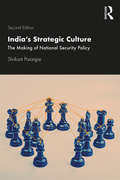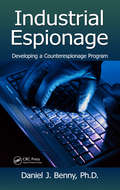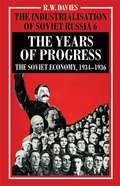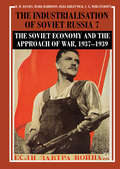- Table View
- List View
India’s Naval Diplomacy: Contours and Constraints
by P.V. RaoThis book studies India’s evolving naval engagements with other nations of the Indian Ocean region. It traces the growth of the Indian Navy and discusses its role as an instrument of meeting national objectives, particularly for furthering foreign policy. The volume analyses themes such as Indian Navy’s (IN) transition from a brown water to blue water force, Indian maritime debates and doctrines, naval ‘bridge-building’ missions, and Sino-Indian maritime competitions. It examines Indian Navy’s regional roles within the broader framework of its diplomatic objectives in particular regions and looks at how keen regional states are to accept India as a crisis manager and would allow it to build a regional maritime security architecture. The author also discusses state control over naval diplomatic roles and investigates if Indian Navy can effectively hedge extra-regional, mainly Chinese, involvement in the Indian Ocean. An important study of India’s naval prowess, this book will be indispensable to students and researchers of political science, international relations, maritime and naval studies, strategic studies, geopolitics, defence studies, conflict studies, diplomacy, Indian Ocean studies, South Asian studies and those interested in India-China maritime rivalry.
India's Naval Strategy and Asian Security (Cass Series: Naval Policy and History)
by C. Raja Mohan Anit MukherjeeThis book examines India’s naval strategy within the context of Asian regional security. Amidst the intensifying geopolitical contestation in the waters of Asia, this book investigates the growing strategic salience of the Indian Navy. Delhi’s expanding economic and military strength has generated a widespread debate on India’s prospects for shaping the balance of power in Asia. This volume provides much needed texture to the abstract debate on India’s rise by focusing on the changing nature of India’s maritime orientation, the recent evolution of its naval strategy, and its emerging defence diplomacy. In tracing the drift of the Navy from the margins of Delhi’s national security consciousness to a central position, analysing the tension between its maritime possibilities and the continentalist mind set, and in examining the gap between the growing external demands for its security contributions and internal ambivalence, this volume offers rare insights into India’s strategic direction at a critical moment in the nation’s evolution. By examining the internal and external dimensions of the Indian naval future, both of which are in dynamic flux, the essays here help a deeper understanding of India’s changing international possibilities and its impact on Asian and global security. This book will be of much interest to students of naval strategy, Asian politics, security studies and IR, in general.
India's Naval Strategy and Asian Security (Cass Series: Naval Policy and History)
by C. Raja Mohan Anit MukherjeeThis book examines India’s naval strategy within the context of Asian regional security. Amidst the intensifying geopolitical contestation in the waters of Asia, this book investigates the growing strategic salience of the Indian Navy. Delhi’s expanding economic and military strength has generated a widespread debate on India’s prospects for shaping the balance of power in Asia. This volume provides much needed texture to the abstract debate on India’s rise by focusing on the changing nature of India’s maritime orientation, the recent evolution of its naval strategy, and its emerging defence diplomacy. In tracing the drift of the Navy from the margins of Delhi’s national security consciousness to a central position, analysing the tension between its maritime possibilities and the continentalist mind set, and in examining the gap between the growing external demands for its security contributions and internal ambivalence, this volume offers rare insights into India’s strategic direction at a critical moment in the nation’s evolution. By examining the internal and external dimensions of the Indian naval future, both of which are in dynamic flux, the essays here help a deeper understanding of India’s changing international possibilities and its impact on Asian and global security. This book will be of much interest to students of naval strategy, Asian politics, security studies and IR, in general.
India's Nuclear Policy (Praeger Security International)
by Bharat KarnadThis book examines the Indian nuclear policy, doctrine, strategy and posture, clarifying the elastic concept of credible minimum deterrence at the center of the country's approach to nuclear security. This concept, Karnad demonstrates, permits the Indian nuclear forces to be beefed up, size and quality-wise, and to acquire strategic reach and clout, even as the qualifier minimum suggests an overarching concern for moderation and economical use of resources, and strengthens India's claims to be a responsible nuclear weapon state.Based on interviews with Indian political leaders, nuclear scientists, and military and civilian nuclear policy planners, it provides unique insights into the workings of India's nuclear decision-making and deterrence system. Moreover, by juxtaposing the Indian nuclear policy and thinking against the theories of nuclear war and strategic deterrence, nuclear escalation, and nuclear coercion, offers a strong theoretical grounding for the Indian approach to nuclear war and peace, nuclear deterrence and escalation, nonproliferation and disarmament, and to limited war in a nuclearized environment. It refutes the alarmist notions about a nuclear flashpoint in South Asia, etc. which derive from stereotyped analysis of India-Pakistan wars, and examines India's likely conflict scenarios involving China and, minorly, Pakistan.
India’s Strategic Culture: The Making of National Security Policy
by Shrikant ParanjpeThis book provides a comprehensive understanding of the evolution of India’s strategic culture in the era of globalization. It examines dominant themes that have governed India’s foreign and security policy and events which have shaped India’s role in global politics. The author Examines the traditional and new approaches to diplomacy and the state’s response to internal and external conflicts; Delineates policy pillars which are required to protect the state’s strategic interests and forge new relationships in the current geopolitical climate; Compares the domestic and international security policies followed during the tenures of Narsimha Rao, Atal Bihari Vajpayee and Manmohan Singh; and Analyzes how the Narendra Modi era has brought on changes in India’s security strategy and the use of soft power and diplomacy. With extensive additions, drawing on recent developments, this edition of the book will be a key text for scholars, teachers and students of defence and strategic studies, international relations, history, political science and South Asian studies.
India’s Strategic Culture: The Making of National Security Policy
by Shrikant ParanjpeThis book provides a comprehensive understanding of the evolution of India’s strategic culture in the era of globalization. It examines dominant themes that have governed India’s foreign and security policy and events which have shaped India’s role in global politics. The author Examines the traditional and new approaches to diplomacy and the state’s response to internal and external conflicts; Delineates policy pillars which are required to protect the state’s strategic interests and forge new relationships in the current geopolitical climate; Compares the domestic and international security policies followed during the tenures of Narsimha Rao, Atal Bihari Vajpayee and Manmohan Singh; and Analyzes how the Narendra Modi era has brought on changes in India’s security strategy and the use of soft power and diplomacy. With extensive additions, drawing on recent developments, this edition of the book will be a key text for scholars, teachers and students of defence and strategic studies, international relations, history, political science and South Asian studies.
India's War: The Making of Modern South Asia, 1939-1945
by Srinath RaghavanBetween 1939 and 1945 India changed to an extraordinary extent. Millions of Indians suddenly found themselves as soldiers, fighting in Europe and North Africa but also - something simply never imagined - against a Japanese army threatening to invade eastern India. Many more were pulled into the vortex of wartime mobilization.Srinath Raghavan's compelling and original book gives both a surprising new account of the fighting and of life on the home front. For Indian nationalists the war has tended to be seen as a distraction from the quest for national independence - but Raghavan shows that in fact the war lay at the very heart of how and why colonial rule ended in South Asia.By seeing the Second World War through Indian eyes, Raghavan transforms our understanding of the conflict - with famous battles such as those in North Africa and Iraq reinterpreted, as well as fascinating and little known campaigns such as the destruction of Italian northeast Africa. Time and again, it was Indian troops that made Britain into a global power and, as the war came to an end, it was the Indian army that fought the final battles which marked the end both of the Japanese empire, and of the British.
The Indoctrination of the Wehrmacht: Nazi Ideology and the War Crimes of the German Military
by Bryce SaitFar from the image of an apolitical, “clean” Wehrmacht that persists in popular memory, German soldiers regularly cooperated with organizations like the SS in the abuse and murder of countless individuals during the Second World War. This in-depth study demonstrates that a key factor in the criminalization of the Wehrmacht was the intense political indoctrination imposed on its members. At the instigation of senior leadership, many ordinary German soldiers and officers became ideological warriors who viewed their enemies in racial and political terms—a project that was but one piece of the broader effort to socialize young men during the Nazi era.
The Indomitable Florence Finch: The Untold Story of a War Widow Turned Resistance Fighter and Savior of American POWs
by Robert J. Mrazek"An American hero-long forgotten-finally gets her due in this riveting narrative. You will absolutely love Florence Finch: her grit, her compassion, her fight. This isn't just history; she is a woman for our times." -Keith O'Brien, the New York Times bestselling author of Fly Girls The riveting story of an unsung World War II hero who saved countless American lives in the Philippines, told by an award-winning military historian.When Florence Finch died at the age of 101, few of her Ithaca, NY neighbors knew that this unassuming Filipina native was a Presidential Medal of Freedom recipient, whose courage and sacrifice were unsurpassed in the Pacific War against Japan. Long accustomed to keeping her secrets close in service of the Allies, she waited fifty years to reveal the story of those dramatic and harrowing days to her own children.Florence was an unlikely warrior. She relied on her own intelligence and fortitude to survive on her own from the age of seven, facing bigotry as a mixed-race mestiza with the dual heritage of her American serviceman father and Filipina mother.As the war drew ever closer to the Philippines, Florence fell in love with a dashing American naval intelligence agent, Charles "Bing" Smith. In the wake of Bing's sudden death in battle, Florence transformed from a mild-mannered young wife into a fervent resistance fighter. She conceived a bold plan to divert tons of precious fuel from the Japanese army, which was then sold on the black market to provide desperately needed medicine and food for hundreds of American POWs. In constant peril of arrest and execution, Florence fought to save others, even as the Japanese police closed in. With a wealth of original sources including taped interviews, personal journals, and unpublished memoirs, The Indomitable Florence Finch unfolds against the Bataan Death March, the fall of Corregidor, and the daily struggle to survive a brutal occupying force. Award-winning military historian and former Congressman Robert J. Mrazek brings to light this long-hidden American patriot. The Indomitable Florence Finch is the story of the transcendent bravery of a woman who belongs in America's pantheon of war heroes.
The Indomitable Florence Finch: The Untold Story of a War Widow Turned Resistance Fighter and Savior of American POWs
by Robert J. Mrazek"An American hero-long forgotten-finally gets her due in this riveting narrative. You will absolutely love Florence Finch: her grit, her compassion, her fight. This isn't just history; she is a woman for our times." -Keith O'Brien, the New York Times bestselling author of Fly Girls The riveting story of an unsung World War II hero who saved countless American lives in the Philippines, told by an award-winning military historian.When Florence Finch died at the age of 101, few of her Ithaca, NY neighbors knew that this unassuming Filipina native was a Presidential Medal of Freedom recipient, whose courage and sacrifice were unsurpassed in the Pacific War against Japan. Long accustomed to keeping her secrets close in service of the Allies, she waited fifty years to reveal the story of those dramatic and harrowing days to her own children.Florence was an unlikely warrior. She relied on her own intelligence and fortitude to survive on her own from the age of seven, facing bigotry as a mixed-race mestiza with the dual heritage of her American serviceman father and Filipina mother.As the war drew ever closer to the Philippines, Florence fell in love with a dashing American naval intelligence agent, Charles "Bing" Smith. In the wake of Bing's sudden death in battle, Florence transformed from a mild-mannered young wife into a fervent resistance fighter. She conceived a bold plan to divert tons of precious fuel from the Japanese army, which was then sold on the black market to provide desperately needed medicine and food for hundreds of American POWs. In constant peril of arrest and execution, Florence fought to save others, even as the Japanese police closed in. With a wealth of original sources including taped interviews, personal journals, and unpublished memoirs, The Indomitable Florence Finch unfolds against the Bataan Death March, the fall of Corregidor, and the daily struggle to survive a brutal occupying force. Award-winning military historian and former Congressman Robert J. Mrazek brings to light this long-hidden American patriot. The Indomitable Florence Finch is the story of the transcendent bravery of a woman who belongs in America's pantheon of war heroes.
Indomitable Will: Turning Defeat into Victory from Pearl Harbor to Midway
by Charles KupferSome of the worst military disasters in U.S. history occurred between Pearl Harbor on December 7, 1941 and the Battle of Midway in June 1942. During this period, the American people faced a barrage of bad news and accounts of defeats and retreats. Yet if they were shocked and dismayed, they showed little panic. Indomitable Will resurrects the legacy of this first half-year of American combat during WWII -a legacy of pain, but not of woe. Historian Charles Kupfer recounts the story of the war's early defeats: Bataan, Corregidor, Wake Island, and the Java Sea. Some of these battles remain evocative today; others are obscure; all were catastrophes for American arms. Kupfer asserts, however, that later victories were made inevitable by the steeling effect of those initial disasters. Weaving together military, journalistic, political, and cultural histories, this engaging book shows that by setting their collective will on victory, Americans in and out of uniform gained strength from their setbacks. Indomitable Will spells out how the nation turned early defeat into ultimate victory.
Indomitable Will: Turning Defeat into Victory from Pearl Harbor to Midway
by Charles KupferSome of the worst military disasters in U.S. history occurred between Pearl Harbor on December 7, 1941 and the Battle of Midway in June 1942. During this period, the American people faced a barrage of bad news and accounts of defeats and retreats. Yet if they were shocked and dismayed, they showed little panic. Indomitable Will resurrects the legacy of this first half-year of American combat during WWII -a legacy of pain, but not of woe. Historian Charles Kupfer recounts the story of the war's early defeats: Bataan, Corregidor, Wake Island, and the Java Sea. Some of these battles remain evocative today; others are obscure; all were catastrophes for American arms. Kupfer asserts, however, that later victories were made inevitable by the steeling effect of those initial disasters. Weaving together military, journalistic, political, and cultural histories, this engaging book shows that by setting their collective will on victory, Americans in and out of uniform gained strength from their setbacks. Indomitable Will spells out how the nation turned early defeat into ultimate victory.
The Indonesian Genocide of 1965: Causes, Dynamics and Legacies (Palgrave Studies in the History of Genocide)
by Katharine McGregor Jess Melvin Annie PohlmanThis collection of essays by Indonesian and foreign contributors offers new and highly original analyses of the mass violence in Indonesia which began in 1965 and its aftermath. Fifty years on from one the largest genocides of the twentieth century, they probe the causes, dynamics and legacies of this violence through the use of a wide range of sources and different scholarly lenses. Chapter 12 of this book is available open access under a CC BY 4.0 license at link.springer.com.
The Indonesian Genocide of 1965: Causes, Dynamics and Legacies (Palgrave Studies in the History of Genocide)
by Katharine McGregor Jess Melvin Annie PohlmanThis collection of essays by Indonesian and foreign contributors offers new and highly original analyses of the mass violence in Indonesia which began in 1965 and its aftermath. Fifty years on from one the largest genocides of the twentieth century, they probe the causes, dynamics and legacies of this violence through the use of a wide range of sources and different scholarly lenses. Chapter 12 of this book is available open access under a CC BY 4.0 license at link.springer.com.
Indonesia’s Foreign Policy and Grand Strategy in the 21st Century: Rise of an Indo-Pacific Power (Asian Security Studies)
by Vibhanshu ShekharThis book examines the changes in Indonesian foreign policy during the 21st century as it seeks to position itself as a great power in the Indo-Pacific region. The rise of 21st-century Indonesia is becoming a permanent fixture in both the domestic and global discourses. Though there has been an increasing level of discussion on Indonesia’s emerging power status, there has been little discussion on how the country is debating and signalling its new-found status. This book combines the insights of both neo-classical realism and social identity theory to discuss a reset in an emerging Indonesia’s foreign policy during the 21st century while emphasizing domestic drivers and constraints of its international behaviour. There are three key organizing components of the book – emerging power, status signalling and the Indo-Pacific region. The Indo-Pacific region constitutes a spatial framing of the book; the emerging power provides an analytical category to explain Indonesia’s changing international status; and status signalling explains multiple facets of international behaviour through which the country is projecting its new status. Though leaders are adding different styles and characteristics to the rising Indonesia narrative, there are a few unmistakable overarching trends that highlight an increasing correlation between the country’s rising power and growing ambition in international behaviour. This book is built around four key signalling strategies of Indonesia as an emerging power – expanded regional canvas, power projection, leadership projection, and quest for great power parity. They represent Indonesia’s growing desire for a status-consistent behaviour, its response to the prevailing strategic uncertainty in the Indo-Pacific region and its attempt to advance its strategic interests. This book will be of much interest to students of South-East Asian politics, strategic studies, international diplomacy, security studies and IR in general.
Indonesia’s Foreign Policy and Grand Strategy in the 21st Century: Rise of an Indo-Pacific Power (Asian Security Studies)
by Vibhanshu ShekharThis book examines the changes in Indonesian foreign policy during the 21st century as it seeks to position itself as a great power in the Indo-Pacific region. The rise of 21st-century Indonesia is becoming a permanent fixture in both the domestic and global discourses. Though there has been an increasing level of discussion on Indonesia’s emerging power status, there has been little discussion on how the country is debating and signalling its new-found status. This book combines the insights of both neo-classical realism and social identity theory to discuss a reset in an emerging Indonesia’s foreign policy during the 21st century while emphasizing domestic drivers and constraints of its international behaviour. There are three key organizing components of the book – emerging power, status signalling and the Indo-Pacific region. The Indo-Pacific region constitutes a spatial framing of the book; the emerging power provides an analytical category to explain Indonesia’s changing international status; and status signalling explains multiple facets of international behaviour through which the country is projecting its new status. Though leaders are adding different styles and characteristics to the rising Indonesia narrative, there are a few unmistakable overarching trends that highlight an increasing correlation between the country’s rising power and growing ambition in international behaviour. This book is built around four key signalling strategies of Indonesia as an emerging power – expanded regional canvas, power projection, leadership projection, and quest for great power parity. They represent Indonesia’s growing desire for a status-consistent behaviour, its response to the prevailing strategic uncertainty in the Indo-Pacific region and its attempt to advance its strategic interests. This book will be of much interest to students of South-East Asian politics, strategic studies, international diplomacy, security studies and IR in general.
Industrial Collaboration in Nazi-Occupied Europe: Norway in Context (Palgrave Studies in Economic History)
by Hans Otto Frøland Mats Ingulstad Jonas SchernerThis book brings together leading experts to assess how and whether the Nazis were successful in fostering collaboration to secure the resources they required during World War II. These studies of the occupation regimes in Norway and Western Europe reveal that the Nazis developed highly sophisticated instruments of exploitation beyond oppression and looting. The authors highlight that in comparison to the heavy manufacturing industries of Western Europe, Norway could provide many raw materials that the German war machine desperately needed, such as aluminium, nickel, molybdenum and fish. These chapters demonstrate that the Nazis provided incentives to foster economic collaboration, hoping that these would make every mine, factory and smelter produce at its highest level of capacity. All readers will learn about the unique part of Norwegian economic collaboration during this period and discover the rich context of economic collaboration across Europe during World War II.
Industrial Espionage: Developing a Counterespionage Program
by Daniel J. BennyThe FBI estimates that billions of U.S. dollars are lost each year to foreign and domestic competitors who deliberately target industrial trade secrets. And, although today‘s organizations face unprecedented threats to the security of their proprietary information and assets, most books on industrial espionage fail to supply guidelines for establis
The Industrialisation of Soviet Russia Volume 6: The Soviet Economy, 1934-1936
by R. DaviesBased on extensive research in formerly secret archives, this volume examines the progress of Soviet industrialisation against the background of the rising threat of aggression from Germany, Japan and Italy, and the consolidation of Stalin's power.
The Industrialisation of Soviet Russia Volume 7: The Soviet Economy and the Approach of War, 1937–1939
by Mark Harrison R. W. Davies Stephen G. Wheatcroft Oleg KhlevniukThis book concludes The Industrialisation of Soviet Russia, an authoritative account of the Soviet Union’s industrial transformation between 1929 and 1939. The volume before this one covered the ‘good years’ (in economic terms) of 1934 to 1936. The present volume has a darker tone: beginning from the Great Terror, it ends with the Hitler-Stalin pact and the outbreak of World War II in Europe. During that time, Soviet society was repeatedly mobilised against internal and external enemies, and the economy provided one of the main arenas for the struggle. This was expressed in waves of repression, intensive rearmament, the increased regimentation of the workforce and the widespread use of forced labour.
Industry and Air Power: The Expansion of British Aircraft Production, 1935-1941 (Studies in Air Power #Vol. 5)
by Noel Sebastian Ritchie Sebastian RitchieThe author begins with a general survey of British aircraft manufacturing in the inter-war period. Policy, production, finance and contracts are examined, and the final chapter is concerned with the mobilization of the aircraft industry in 1939, and the emergency measures of 1940.
Industry and Air Power: The Expansion of British Aircraft Production, 1935-1941 (Studies in Air Power)
by Noel Sebastian Ritchie Sebastian RitchieThe author begins with a general survey of British aircraft manufacturing in the inter-war period. Policy, production, finance and contracts are examined, and the final chapter is concerned with the mobilization of the aircraft industry in 1939, and the emergency measures of 1940.
An Infamous Army: A Novel Of Wellington, Waterloo, Love And War (Historical Romances Ser. #9)
by Georgette HeyerThe Battle of Waterloo. A heart-racing tale of adventure, love and fate against the backdrop of one of the most decisive battles in history by one of the greatest and best-selling romantic novelists of all time.In 1815, beneath the aegis of the Army of Occupation, Brussels is the gayest town in Europe. And the widow Lady Barbara Childe, renowned for being as outrageous as she is beautiful, is at the centre of all that is fashionable and light-hearted. When she meets Charles Audley, dashing aide-de-camp to the great Duke of Wellington himself, her joie de vivre knows no bounds - until the eve of the fateful Battle of Waterloo ...Georgette Heyer was the creator - greatest practitioner - of the Regency romance, and An Infamous Army shows why she has won the hearts of a whole new audience with her sweeping historical fiction.
Infantry Antiaircraft Missiles: Man-Portable Air Defense Systems (Weapon)
by Steven J. ZalogaNoted authority Steven J. Zaloga charts the development, combat use, and influence of man-portable air defense systems, from the late 1960s to the present day.The first attempts at developing a man-portable air defense system (MANPADS) based around a guided missile began in the mid-1950s, as a response to the increased speed and maneuverability of jet aircraft. This book charts the technological evolution of the MANPADS and explores their combat usage and the lessons from these encounters. Besides detailing the missiles, it also surveys the various methods developed as countermeasures to the MANPADS threat.The first generation of MANPADS, such as the US Army's Redeye and the Soviet Strela-2 (SA-7 Grail), saw combat use in the Vietnam War in 1972 and the Yom Kippur War of 1973. The next generation of infrared-guided MANPADS, such as the US Stinger and Soviet Igla, came to prominence following the Soviet invasion of Afghanistan in 1979. Since the 1970s, MANPADS have been used in innumerable wars, border conflicts, civil wars and insurrections. Featuring specially commissioned artwork and carefully chosen photographs, this study tells the story of these lethally effective weapons, from their origins to their use today.
Infantry Antiaircraft Missiles: Man-Portable Air Defense Systems (Weapon)
by Steven J. ZalogaNoted authority Steven J. Zaloga charts the development, combat use, and influence of man-portable air defense systems, from the late 1960s to the present day.The first attempts at developing a man-portable air defense system (MANPADS) based around a guided missile began in the mid-1950s, as a response to the increased speed and maneuverability of jet aircraft. This book charts the technological evolution of the MANPADS and explores their combat usage and the lessons from these encounters. Besides detailing the missiles, it also surveys the various methods developed as countermeasures to the MANPADS threat.The first generation of MANPADS, such as the US Army's Redeye and the Soviet Strela-2 (SA-7 Grail), saw combat use in the Vietnam War in 1972 and the Yom Kippur War of 1973. The next generation of infrared-guided MANPADS, such as the US Stinger and Soviet Igla, came to prominence following the Soviet invasion of Afghanistan in 1979. Since the 1970s, MANPADS have been used in innumerable wars, border conflicts, civil wars and insurrections. Featuring specially commissioned artwork and carefully chosen photographs, this study tells the story of these lethally effective weapons, from their origins to their use today.

















